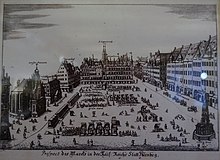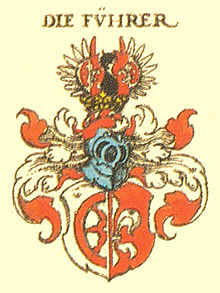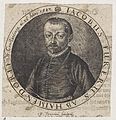Fürer von Haimendorf
The Fürers von Haimendorf are one of the oldest patrician families in the imperial city of Nuremberg - first mentioned in a document in 1295. The Fürers were, with brief interruptions, from 1501 until the end of the imperial city period in 1806, represented in the “Inner Council” and belonged to them the “ dance statute ” to the “first admitted” sexes capable of counseling and thus to the Nuremberg patriciate .
The family seat is still the Haimendorf Castle, inherited from Tuchers' property in 1476 (destroyed in the Second Margrave War, later rebuilt on the old foundation walls).
history
Originally probably from Alsace , the Fürer family settled in the imperial city of Nuremberg in the 13th century . In 1295 King Adolf von Nassau pledged the office of Heroldsberg to Konrad Fürer.
The princes achieved prosperity through trade with France and Poland , but forestry and mining were also lucrative fields of activity. Around 1500 they rose to become one of the leading Nuremberg mining companies. Her interest lay particularly in the Mansfeld and Thuringian copper mining and the Saiger trade . The wholesale merchant and councilor Christoph Fürer (1479–1537) founded the Saiger trade cartel in 1534 . In addition, the Fürer operated in the credit business and traded in yew wood for weapons production. At the end of the 15th century, he was appointed to the Inner Council of the Free Imperial City - from now on one helped determine the political fate of Nuremberg.
In 1476, through the marriage of Sigmund Fürer to Anna Tucher, Haimendorf Castle came to the family, which has been their ancestral home since then. In 1599 the family was awarded the title of nobility . Three lines emerged, named after the respective mansions : “Haimendorf”, “ Himmelgarten ” (1568–1844) and “ Steinbühl ” (1630–1677). Only the Haimendorfer main line still exists today. It divided into an older, Catholic (Christoph'schen) branch in Bohemia and a younger, Protestant (Carl-Gottlieb'schen) in Nuremberg.
Both were registered on March 4, 1813 in the royal Bavarian nobility register. From the Bohemian branch, Karl Fürer von Haimendorf and Wolkersdorf owned the Hojeschin estate near Setsch from 1814 to 1839 . Descendants of the two branches live in Haimendorf and Munich as well as in Vienna , near Linz and in London .
The Fürer von Haimendorf family was closely connected to the Gnadenberg monastery for centuries and also provided an abbess in Elisabeth Fürer .
Possessions (extract)

The family still owns:
- the Fürerschloss Haimendorf
- the Mauritius chapel on the Moritzberg
- the hunting lodge "Brunnenhof" in Rockenbrunn
Former possessions (extract)
From 1445 the Fürers' seat in Nuremberg was the “Fürershof” at Maxtor (today the area of the old building of the Johannes-Scharrer-Gymnasium Nuremberg ). For a time they also owned the large house No. 505–508 on the main market .
They also owned:
- 1295–1299 the village of Heroldsberg (later the seat of the Geuder )
- ???? - 1523 the village and the manor Heuchling near Lauf an der Pegnitz
- 1522–1523 the tentnerschloss in Gleißhammer
- 1539–1584, Kugelhammer Castle in Röthenbach near Sankt Wolfgang
- 1558–1847 the village and the manor house Renzenhof
- 1568–1844 the Himmelgarten estate
- 1580–1840 the Scheerau manor (Leinburg)
- 1630–1677 the Steinbühl manor - Wiesenstraße 19 (proprietary right - a kind of mortgage - until the 19th century, destroyed in 1945)
- 1630–1843 the castle and property in Wolkersdorf near Schwabach
- 1631–1642 Malmsbach Castle
- 1663 - ???? the village of Sandreuth
- 1730–1833 the Weiherhaus in Röthenbach near Schweinau ( Faberpark )
- 1732-17 ?? the Hirschvogelsaal (also: Hirsvogelsaal ) with property
- 1770–1777 the Bremen headquarters in Mögeldorf
Renzenhof manor
Himmelgarten mansion
Scheerau manor
Wolkersdorf manor
Known family members
- Christoph Fürer von Haimendorf (1479–1537) - wholesale merchant, Nuremberg councilor, founder of the Saiger trade cartel (1534)
- Susanna Fürer von Haimendorf - wife of the baroque poet Georg Philipp Harsdörffer (married on June 9, 1634)
- Christoph Fürer von Haimendorf auf Wolkersdorf (1663–1732) - poet, President of the Pegnese Order of Flowers , from 1725 Vorderster Losunger (administrator of the city taxes ) and Reichsschultheiß of Nuremberg and castellan of the Reichsveste
- Christoph von Fürer-Haimendorf (1909–1995), Austrian ethnologist , is considered the doyen of the ethnology of the Himalayan peoples
Christoph Fürer von Haimendorf (1578–1656), Reichsschultheiß , councilor
Christoph Fürer von Haimendorf (1663–1732), foremost Losunger, poet
Sigmund Friedrich Fürer von Haimendorf, from 1791 the last caretaker of the Mendelschen Twelve Brothers Foundation
coat of arms
Family coat of arms: semicircular shield, split by red and silver, in mixed up tinctures half a lily in front, half a wheel behind.
The older line has a quartered coat of arms with the family coat of arms as a heart shield, 1 and 4 in gold a crowned black eagle, 2 and 3 under the head of a cloud shield divided by black and gold, with a crowned lion in confused colors, facing the dividing line. Two crowned helmets, on the first a crowned growing black eagle, split between open flight on the right by red and silver, on the left by silver and red, and each covered with the images of the trunk shield in alternating colors; on the second the lion between two horns, mistaken for black and gold, and each with three peacock feathers at the tips. Cover red-silver and black-gold.
The younger line leads the trunk shield with the first helmet, but with an uncrowned eagle.
Coat of arms pane Lorenzkirche , 1514 (Fürer / Holzschuher )
Ex-libris of Hieronymus Ebner (1516) with the marital alliance coat of arms Ebner / Fürer, woodcut by Albrecht Dürer , 1516
Schembartrunner with Fürer coat of arms, 1540
Coat of arms in St. Egidien , 18th century.
literature
- Christoph von Imhoff (Hrsg.): Famous Nuremberg from nine centuries . Nuremberg: Hofmann, 1984, 425 pages, ISBN 3-87191-088-0 ; 2., erg. U. exp. Edition, 1989, 459 p .; New edition: Edelmann GmbH Buchhandlung, October 2000
- Michael Diefenbacher : Prince of Haimendorf, patrician family . In: Michael Diefenbacher, Rudolf Endres (Hrsg.): Stadtlexikon Nürnberg . 2nd, improved edition. W. Tümmels Verlag, Nuremberg 2000, ISBN 3-921590-69-8 ( online ).
See also
- Patriciate (Nuremberg)
- History of the city of Nuremberg
- Castles, palaces and mansions in the city of Nuremberg
swell
- ^ The Bohemian nobility , by Rudolf Joh. Count Meraviglia-Crivelli
- ↑ The Hirsvogelsaal owned by the Fürers
- ↑ Glossary German-New High German ( Memento of the original dated December 31, 2013 in the Internet Archive ) Info: The archive link was inserted automatically and has not yet been checked. Please check the original and archive link according to the instructions and then remove this notice. , uni-hamburg.de. Retrieved December 30, 2013.
Web links
- Coat of arms of the Fürer von Haimendorf family
- City of Röthenbach - information on Haimendorf, Himmelgarten, Renzenhof and Moritzberg
- Tourist-Information Frankenalb - short encyclopedia article on the family seat
- From the correspondence between the Fürer von Haimendorf patrician family from Nuremberg and the Gnadenberg monastery in the Upper Palatinate. 1460-1540




















